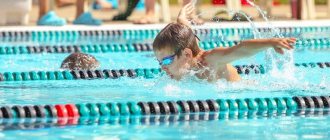Athletics
ATHLETICS: A SPORT AVAILABLE TO EVERYONE
Athletics is often called the “queen of sports.” Indeed, it is difficult to find a sport that could compete in popularity with athletics, the history of which dates back to the times of Ancient Greece. Athletics was included in the program of the first Olympic Games. And the games themselves at that time consisted mainly of disciplines of this sport. At first, the Olympians competed in a race over a distance of 192 meters (this was the length of the Olympic stadium in Ancient Greece). Later, the program included running in both directions - back and forth. Later, sports pentathlon and relay competitions appeared. A mandatory attribute of the relay race was a burning torch, which the participant passed on to the next athlete.
Athletics was also popular in European countries, in particular in Britain. Competitions in high and long jumps, throwing and running were held here already in the 12th century. Most of the championships of that time became the basis for modern athletics disciplines. Interest in athletics flared up with renewed vigor in 1859, when the Olympic Games were revived in Greece. Athletics took center stage in the national championship.
Disciplines
Athletics covers several sporting disciplines. Among them are running at different distances, jumping, projectile throwing, race walking, and marathon. All these types of athletics are united by accessibility: running, throwing and race walking can be practiced at any age.
Benefit for health
The health benefits of athletics are obvious. In the process of regular training or running for health, all muscle groups develop. Proper breathing helps saturate organs and tissues with oxygen, improves blood circulation, which is necessary for the prevention of many diseases. The body is constantly in good shape. Athletics is considered the most accessible sport that can be practiced at any age. Regular training does not require large material costs, since beginner athletes only need the appropriate uniform and shoes in terms of sports equipment and accessories.
Athletics for children
Athletics classes are especially useful for children and teenagers, as they develop endurance, speed, and good reaction. You can start playing athletics at school age – from 9-10 years old. And you can start training at the age of 15 - there are no strict age restrictions in this case. The main thing is that the child’s body is adapted to intense sports loads.
Selecting a discipline
Often parents independently decide for their child what kind of sport to engage in. When choosing athletics disciplines, it is necessary to take into account the opinion of the child himself, as well as some other criteria, for example, a child under 7 years old is unlikely to be able to seriously engage in workout. If a girl or boy is tall and has long legs, then long or high jumps can be considered. It is better for short children to take up middle- or long-distance running, since most champion athletes in this discipline are short and light in weight. In general, in athletics, as in any sport, personal qualities are important. Drive, concentration, willpower and the desire to win will help novice athletes overcome difficulties in any sports discipline.
Benefit
- Jogging has a good effect and strengthens the cardiovascular system , as there is constant tension and relaxation of the leg muscles.
- Capillaries undergo good training , their number increases several times. They become more flexible and spacious, so they can deliver more oxygen and nutrients to different parts of the body. During sports, the body's metabolism increases, blood circulation improves, so excess calories are actively consumed.
- It is a proven fact that absolutely all types of running have a positive effect on the functioning of the endocrine system and strengthen the immune system .
- And athletics also perfectly develop skills such as agility , endurance and reaction speed .
- During physical activity, breathing becomes deeper and more frequent , as a result of which the supply of oxygen to the tissues increases. Thanks to this, physical and mental performance increases.
- Running for 30 minutes to 1 hour activates the breakdown of cells , and therefore the production of new ones . Due to the fact that sick and old cells are destroyed first, the body is renewed and rejuvenated.
- The hormone serotonin , or as it is also called the hormone of happiness does not stand aside . This makes a person feel happy and rested after a run.
- There is an excellent workout for all muscle groups - abs, legs, back, buttocks. Therefore, people who constantly engage in athletics have good posture and a toned body.
- Average statistics show that people who run live 5 years longer .
- Brief evening exercise will also help improve your sleep quality .
- Thanks to morning jogging, the body will be able to wake up faster and recharge itself with energy for the whole day, and it will also help get rid of lack of appetite.
- There is a reduction in the risk of hypertension and hypotension.
- The likelihood of a stroke or heart attack is halved.
- Running when the sun is shining outside will be doubly beneficial because a person gets vitamin D .
- Sport perfectly develops self-confidence and increases self-esteem .
- Regular jogging will help solve problems with chronic fatigue .
- Jogging in winter can be more beneficial than in summer, since during the cold season more muscles are involved due to the slippery surface.
- Running will help develop a person's determination, willpower and self-control.
Athletics and health
What athletics is does not need to be explained to anyone. After all, the Olympic Games, held back in Ancient Greece, were based on track and field sports. Running, jumping, throwing - these exercises are natural for a person, because he has been performing them since childhood. What child doesn’t want to catch up and overtake his dad or mom, jump further than his peers and throw the ball as far as possible? This is athletics.
In order to practice this sport, you do not need an expensive gym, an ice rink and expensive equipment, nothing but desire. After all, there is a place for jogging and jumping exercises everywhere. There is no need for an expensive instructor who charges huge amounts of money for a course of classes for which there is a waiting list. You can practice almost all year round. After all, the proverb “There is no bad weather, only bad clothes” is suitable for track and field athletes.
By doing athletics, you will improve your body's health. By doing running exercises, you will train your cardiovascular system and strengthen the muscles of your entire body. Running is not only a load on the legs, but also on the entire body. Naturally, the load should be appropriate to your training. When exercising to improve your health, you don’t need to torture yourself with daily multi-kilometer runs. It is enough to run a few hundred meters to feel self-respect. After all, physical education is also an excellent psychological training, it develops a sense of responsibility and strengthens the nervous system. To strengthen the muscles of your arms and core, you can perform throwing exercises, for example, throwing a tennis ball or just pebbles. By jumping, strengthen your leg muscles and develop flexibility. The main thing is to know moderation in everything.
We should not forget that athletics can and should be done with family or friends. It's much nicer and more fun. It is imperative to involve children in activities so that they grow up strong and healthy.
Even simple walking is considered athletics. And there is no physical exercise easier than walking. Walking the extra mile will make your body more resilient.
If you want to improve your health through exercise but are still hesitant about where to start, start with athletics. Look at the beautiful figures of ancient sculptures - their prototypes were track and field athletes.
Prospects for professionals
Now, when serious participation in sports can become a person’s main profession, many parents strive to send their children to a sport that can support them in the future. It is no secret that the most “profitable” sports today are tennis, football, hockey, and figure skating. However, athletics can also bring in very good money. Prize competitions bring quite impressive fees to the athlete, and there are also many commercial tournaments where famous athletes can be paid just for participation. These are very good prospects, especially considering that material investments in training children, in our times, are minimal. But, of course, you shouldn’t look so far and predict the professional career of a future track and field athlete in advance. It is best to prioritize the benefits of athletics for the health and development of the child, and they undoubtedly exist: the development of endurance, speed, strengthening muscles, and the formation of a good athletic physique. Whatever you say, it’s not for nothing that athletics is considered the queen of sports. And it’s not without reason that two of the three Olympic calls in the motto “Faster, higher, stronger” can be attributed without hesitation to athletics.
Athletics for children is the most natural sport. Having barely learned to walk, the baby immediately strives to master running and various types of jumps, and all these activities help not only to throw out excess energy, but to develop the body. For the human body, running has a general strengthening property that promotes the harmonious development of the entire body, and not just any individual part of it. In addition, endurance is strengthened, which is a very important property for any person.
Athletics for children is very useful and necessary, but it is important that your child has an aptitude for them. Fortunately, this sport allows you to independently determine, by observing your child, whether your baby is suitable for such activities. So, take a closer look at the following factors:
- the child is active, loves to run and jump;
- the child is often the ringleader of children's games;
- The baby’s favorite pastime is to participate in strength and agility competitions with other children;
- your baby strives for leadership and knows how to endure failures;
- the child is harmoniously developed and physically strong.
If all of this or most of these facts are true, then your baby is quite suitable for this kind of activity. It is important to understand that physical activity and hyperactivity are different things. It is not worth sending a hyperactive child to such a section - it will exhaust both him and his coach. This phenomenon relates rather to the mental sphere of life, and athletics cannot have a positive effect on this.
If athletics at school usually uses a variety of areas of this very voluminous concept, then specialized sports schools in athletics require the choice of a specific direction. There are several of them:
- jumps: high, long, pole, triple jump;
- race walking;
- throwing projectiles: discus, hammer, spear, cannonball;
- all-around and relay races.
Of course, you need to choose exclusively together with your child, guided by his abilities and interests. Due to the fact that athletics is familiar to the child at school, it makes sense to find out what he likes most or talk to his physical education teacher.
It is worth understanding that his physique and heredity play an important role (you can often guess how a baby will grow up based on the physique of his parents). For example, any jumps (both high and long) are best suited for long-legged children. But the best runners are light, thin-boned and short guys. If your child is overweight, it will be quite difficult for him to achieve success in this sport, but classes can help your child control his weight.
If your child is inclined to team activities, you can send him to the relay running section - this is where the leading role is given to the coordination of the entire team.
The advantages of athletics, which children usually love, also include the fact that this sport is cheaper for parents than others. All you need is a high-quality sports suit and special athletics sneakers, which reduce the load on the joints and protect the baby from the risk of injury. Don’t forget that you should send your child to such sections between the ages of 7-8 and 11 years old - this is the ideal age for both an amateur and a professional start.
It should be noted that the Public Association “Belarusian Athletics Federation” pays great attention to the development of children's sports. Projects such as “School Games” and “300 Talents for the Queen” are being successfully implemented, which represent an unforgettable sports festival filled with a bright palette of emotions and impressions. You can verify this by watching these wonderful image videos:
REPUBLICAN COMPETITIONS AMONG CHILDREN AND ADOLESCENTS IN ATHLETICS “SCHOLIADA” (2016)
REPUBLICAN MASS SPORTS EVENT “300 TALENTS FOR THE QUEEN” (2016)
Moreover, “300 talents for the Queen” was developed - an Athletics Academy was created for talented children, finalists of the project.
Vladimir Zhuravlev – athletics coach and teacher:
“The essence of the Academy is to unlock the potential of the children we recruited after the 300 Talents for the Queen event.” Since the children come from different parts of Belarus, they live in the dormitory of the Republican State School of Olympic Reserve. There are 16 people studying in class 5 “A” - here we note that the class is experimental, this project is being implemented for the first year, but it is planned to “put it on stream.” The children undergo a basic school program, plus athletics training - 3 times a week in the arena (Monday, Wednesday, Friday) and 2 times a week in the pool (Thursday, Saturday). During training, which lasts 1.5 hours, we develop all qualities, that is, we follow the all-around program, because harmonious development is necessary in childhood. There is no need to focus on, for example, endurance or strength. We fully develop all qualities as a whole. And in the future, if they go to other trainers, there they will conduct targeted training.
Each training session goes something like this: we leave the hostel, arrive at the RCOP, change clothes, and go to the arena. First we do a warm-up - some game exercises, catch-up exercises, for example. Something moving. Then we run a couple of circles. This is followed by a warm-up for all muscle groups. Then, according to the plan, the main part of the training begins - hurdles, ball throwing, jumping. That is, within one lesson we try to involve work in the main types of athletics for speed, endurance, and strength. Depending on how well the guys do, it may take a different amount of time for each complex. But on average, about 20 minutes per view.
I like working with children. This is interesting. I have motivation - I want them to grow up to be worthy athletes and become Olympic champions and medalists, as well as champions of all kinds of international championships. I am a young specialist, coach. I am not afraid to experiment with different methodological approaches and exercises. I'm very interested in what will come of this. My credo as a coach is to instill a love of athletics.”
Also, the Belarusian Athletics Federation regularly conducts training seminars for physical education teachers and children's coaches under the IAAF KIDS' ATHLETICS program (IAAF Children's Athletics). At the end of the seminar, each participant received a certificate from the International Association of Athletics Federations, granting the right to transfer the knowledge acquired at the seminar in the format of the same two-day seminars, disseminating the IAAF system among their colleagues and children, popularizing it in practice. We adopt the experience of leading member federations of the EAA and IAAF. For example, during one of our visits to the French Athletics Federation, our colleagues shared a set of exercises for children aged 5-7, 7-9, 9-11 years old. We are happy to offer them to your attention -
Athletics is called the “queen of sports” for a reason, because other sports are based on the basic training of this crowned person.
Athletics for children: at what age and what are the benefits?
The pros and cons of athletics for children, at what age is it better to start, what medical contraindications exist and how to choose a section - read in our article.
Few people realize, but the child begins to engage in athletics long before the parent takes him to the section: the child overcomes obstacles, climbs onto a ladder, chair or sofa; In the courtyards and during school breaks, enterprising children come up with active fun for themselves - tag, jumping rope, hopscotch. This reflects the simplicity of this sport - it has everything that children like so much. And every parent knows about the benefits of a moderately active lifestyle.
How the training goes
The first lessons in athletics are held in the form of a game. Children perform various exercises - run, overcome a barrier, pump up their abs. When the guys get a little stronger, the approach becomes more specialized. Some children are better at long jumping, others at running, the coach tries to find an approach to each child and develop his inclinations to the fullest.
A large role in choosing the type of discipline in athletics is played by physiological characteristics given from birth.
There is a whole science for selecting future athletes, taking into account the structure of the foot, ankle for runners and jumpers, the volume of muscle mass for discus or shot throwers, etc. Although ideal body parameters do not guarantee success for an athlete. To achieve high results you need perseverance and hard work.
Athletics is the most accessible sport for children, which is taught even in physical education classes. And those who dream of a sports career need to work hard, mastering the program at a sports school.
Athletics is considered to be the “queen of sports”, despite the fact that it is essentially the simplest and most natural form of physical activity. The child will start doing it even before you take him to the section - he runs, barely learning to walk, climbs the steps or jumps on a trampoline. Is this sport too “simple”, and how useful is it?
From what age
Experienced coaches note that athletics, despite its simplicity, is not suitable for preschoolers. It is recommended to start training when the child can already follow the rules of discipline, knows how to control his emotions and concentrate his attention.
You can send your child to athletics at the age of 3, but the benefits will be minimal. The optimal age to start playing athletics is 7-8 years old, when the child is already quite disciplined and physically resilient.
When should classes start?
When a child learns to control his emotions, concentrate his attention and set his first goals. Athletics is not just running or jumping, it is a sport that requires determination and real struggle with an opponent, even if not in the ring.
Experienced coaches note that athletics, despite its simplicity, is not suitable for preschoolers.
“Many parents think that even 4-year-olds can participate in our section, so what’s so difficult about running, for example, a cross-country race? But in fact, such kids waste their and our time in vain; they do not yet understand all the rules of discipline. For example, we spend a lot of time teaching them how to start correctly, some step over the line, others take off ahead of time, and others, on the contrary, cannot react quickly. We can develop this simple skill for about six months, while a first-grader will learn it already in the second or third training,” says the coach of the athletics section at the regional sports school, Oleg Maslov.
So, you can send your child to classes at three years old, but their benefits will be minimal. The most suitable age to start classes is 7-8 years.
For a young schoolchild, training will not just be fun, but a serious activity that requires strict adherence to the rules. A first-grader will quickly understand the value of every second on a runner's distance, will start accurately and accelerate before the finish, which is beyond the power of a three-year-old, who would be more than happy to simply play with a stopwatch.
Often, potential runners and jumpers are chosen right in physical education class - those guys who show the best results in school competitions are boldly invited to the athletics section. Moreover, it is not too late to “get involved” in such a sport even at the age of 13, when most sections will already refuse to admit a child to classes.
Medical contraindications
Athletics should be avoided in cases of heart disease, respiratory system, kidney disease, and also if diabetes mellitus is observed.
Since this sport involves heavy loads on the musculoskeletal system, joints and muscles must be in excellent condition.
It is contraindicated for hyperactive children to engage in athletics. It would be a mistake to think that athletics can discipline an overactive child. In such children, the nervous system is often in a state of excitement. During training, the child will be dominated by emotions and strong excitement, and this can provoke an even greater emotional outburst.
When should classes start?
When a child learns to control his emotions, concentrate his attention and set his first goals. Athletics is not just running or jumping, it is a sport that requires determination and real struggle with an opponent, even if not in the ring.
Experienced coaches note that athletics, despite its simplicity, is not suitable for preschoolers.
“Many parents think that even 4-year-olds can participate in our section, so what’s so difficult about running, for example, a cross-country race? But in fact, such kids waste their and our time in vain; they do not yet understand all the rules of discipline. For example, we spend a lot of time teaching them how to start correctly, some step over the line, others take off ahead of time, and others, on the contrary, cannot react quickly. We can develop this simple skill for about six months, while a first-grader will learn it already in the second or third training,” says the coach of the athletics section at the regional sports school, Oleg Maslov.
So, you can send your child to classes at three years old, but their benefits will be minimal. The most suitable age to start classes is 7-8 years.
For a young schoolchild, training will not just be fun, but a serious activity that requires strict adherence to the rules. A first-grader will quickly understand the value of every second on a runner's distance, will start accurately and accelerate before the finish, which is beyond the power of a three-year-old, who would be more than happy to simply play with a stopwatch.
Often, potential runners and jumpers are chosen right in physical education class - those guys who show the best results in school competitions are boldly invited to the athletics section. Moreover, it is not too late to “get involved” in such a sport even at the age of 13, when most sections will already refuse to admit a child to classes.
pros
Athletics is undoubtedly beneficial for the physical health of children. Thanks to regular exercises, the muscular and skeletal systems are strengthened; strength, agility, speed develops; general endurance to sports loads increases; immunity improves.
In addition to the health benefits, athletics is also good psychologically: the child learns to set and achieve goals, as well as maintain a positive outlook in case of failure.
In addition, athletics is an accessible sport. Classes can take place either in a specially equipped room or in the fresh air: for example, on the sports ground in the school yard. No complex sports equipment is required.
How are classes going?
The training process in athletics is completely different from ordinary physical education lessons at school. The training plan may vary depending on the discipline and training of the athlete.
Classes begin with a warm-up. It includes warming up and stretching. The coach teaches the child not to neglect this stage, since lack of warm-up can lead to injury.
After this, the actual training begins. Children learn to run, jump, acquire race walking skills, and throw athletics equipment. Honing skills within a particular discipline occurs gradually. Children get used to sports activities and develop a developed and strong body.
Recovery also plays an important role in the training process. To avoid overload, some children are even exempted from physical education lessons at school.
How much do classes cost?
Athletics can easily be called the most economical sport. You can do it for free: on the street, on sports and playgrounds. Which, by the way, is an additional advantage - outdoor activities are doubly useful.
Classes at school or at a local children's sports club will not be expensive, unlike other sports sections.
You won’t have to spend a lot on special equipment either. Comfortable sneakers and a tracksuit are all you need. You can keep within 1000 - 2000 rubles.
Entertainment
Unfortunately, unlike football or hockey, athletics can only be spectacular for those who have practiced this sport themselves. For others, most often, athletics in general looks like curling, that is, you seem to be rooting for your own people, but you don’t quite understand what’s what. This also applies to the results of athletes and some types of athletics in general. Of course, most people understand exactly what needs to be done to win. However, only a person with at least a little understanding can understand how much this victory costs.
But if you know what a 7-meter long jump is for a woman, what is it like for a white-skinned athlete to run 100 meters in 10 seconds. How difficult it is to win tactically at 1500 meters, why the world season leader at the next competition cannot even make it to the final of the tournament, then everything that happens at the athletics stadium becomes one whole for you. The German athlete pushed the shot 22 meters, and for you this is not just a number, but a result that will make your eyes pop. The Frenchman jumped over Bubka himself in the pole vault. And this is mega cool. All this creates amazing interest in sports.
But, I repeat, it’s not interesting to watch athletics with beer and chips in front of the TV if you yourself have never even gone for a run.
Will he become a champion?
Have you ever thought about the victories of the little athlete and imagined him on the podium? Don’t lie, it’s a normal desire of parents to rejoice at their child’s successes. But athletics is not such a spectacular and promising sport as, for example, team games or figure skating. But it also has its advantages: a successful athlete will defend the honor of a school or even a city at competitions, and this guarantees the loyalty of teachers.
Of course, when sending your child to a section, you should think not about medals, but about what this sport will personally give him physically and emotionally. Remember that professional sport, even something as “simple” as athletics, carries a risk of injury and childhood disappointment when defeated. Don’t set your child up to “be the best and the first,” let him play sports for fun, without a race for awards.
Athletics, truly the “queen” of sports disciplines, do you doubt it? Then we invite you to watch a video about the beauty and grace of this sport.
What would suit your baby: running, jumping or something else?
Boys love to run races and compete to see who can jump the highest and who can throw the farthest. These are the most natural outdoor games for children of any age. Therefore, without knowing it, boys are involved in athletics - the most popular sport on our planet.
It is precisely due to their unique naturalness and accessibility that competitions in various types of athletics form the basis of the sports program of the Olympic Games. And although athletics originates from childhood fun, it is a rather serious sport where in order to surpass others, you must first defeat yourself. Therefore, when deciding whether to send your son to the athletics section, it is necessary to find out what physical and psychological qualities will be required from the child to participate in athletics.
Which track and field discipline should you choose?
There is plenty to choose from: high and long jumps, middle and long distance running, sprinting (running at maximum speed), steeplechase running, race walking, throwing and many more combined competitions. What exactly your child wants to do will depend on his desire, abilities (here it is better to rely on the opinion of the coach) and physical data. Jumping (both high and long) is mainly suitable for tall and long-legged athletes. In general, be prepared for the fact that when enrolling a child in a section, the coach may inquire about the weight and height of his parents. Naturally, children with a genetic tendency to be overweight or have a digestive physique (in other words, chubby) will have a rather difficult time achieving good results. As for height, if tall jumpers are valued, then all champions in middle and long distance running are always very light and short. Therefore, a child of any height will be able to find a suitable discipline in athletics. Athletics is equally suitable for both individualists and those who want to be part of a team.
It is wrong to think that this is an exclusively individual sport - there are team disciplines here. Therefore, if your son needs to learn how to work in a team, then pay attention, for example, to relay running. What is needed here is perfect team coordination and the ability to feel for a teammate. The relay itself symbolizes team spirit. The same can be said about orienteering classes and some other athletics disciplines.
Institutions (schools, clubs) in the section Athletics for children in Moscow
Here is a list of all athletics sections, athletics clubs and sports schools for children 3, 4, 5, 6, 7, 8, 9, 10 years old, for boys and girls.
The search for a suitable place for athletics in Moscow can be done directly on the map or using the list of represented sports organizations. You can choose a suitable sports section near your children's home, work or school for subsequent enrollment. For each of the sports sections, the following are available: phone numbers, addresses, prices, photos, descriptions and conditions to sign up for a section or clarify other information that interests you. Athletics is called the “queen of sports” for a reason, because other sports are based on the basic training of this crowned person.







